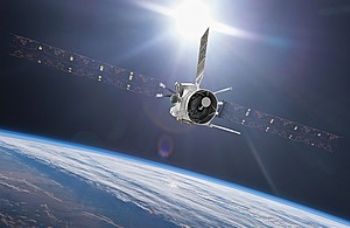
A European Space Agency (ESA) mission to Mercury, made possible with the help of UK scientists, conducted a flyby of Earth on 10 April before it began its journey deeper into the inner Solar System.
The gravity-assist manoeuvre slowed down the BepiColombo spacecraft and bent its trajectory towards the centre of the Solar System as the spacecraft approached Earth at 12,700km, allowing scientists to test some of the instruments onboard.
The flyby was the first of nine gravity-assist manoeuvres awaiting BepiColombo during its seven-year journey to Mercury, and the last time it will be visible from Earth.
Rosemary Young, UK Space Agency science programme manager, said: “The UK-built X-ray spectrometer instrument onboard BepiColombo will eventually tell us so much more about Mercury’s chemical composition but before then the spacecraft must undertake a complex orbit manoeuvre to get there.”
Launched in 2018, BepiColombo is the first ESA mission to Mercury, the least explored planet in the inner Solar System, and will provide new insight into how the planet closest to the Sun formed and evolved.
The spacecraft will travel 9 billion km and is designed to survive extreme temperatures, from +450 to -180degC.
In October, the spacecraft will perform the first of two flybys at Venus.
The final six orbit-tightening manoeuvres will use the gravity of BepiColombo’s destination, Mercury, to arrive in late 2025.
Much of the spacecraft was built in the UK by the growing space sector, which employs more than 40,000 people across the country.
The mission is an outstanding example of international collaboration between the European and Japanese space agencies. The UK’s involvement is managed and funded by the UK Space Agency.
The UK Space Agency funded, and University of Leicester designed and built the Mercury Imaging X-ray Spectrometer (MIXS).
This instrument will use novel X-ray optics to determine small-scale features on Mercury and find out what the planet’s surface is made of.
Airbus Defence and Space provided spacecraft structures, electrical and chemical propulsion systems and the systems which will separate the spacecraft modules on arrival at Mercury.
Meanwhile, QinetiQ supplied the innovative electric propulsion system — a beam of charged particles are expelled from the spacecraft to propel it forward.
Ion propulsion produces low levels of thrust very efficiently compared with conventional chemical rockets.
Thales Alenia Space UK supplied the Remote Interface Units that acquire sensor data and telemetry as well as driving the thrusters that control the spacecraft.
UK teams also provided a hardware contribution to the Finnish led Solar Intensity X-ray & particle spectrometer (SIXS).
The UK continues to be a leading member of ESA, which is independent of the European Union, having committed a record investment of £374 million per year in November 2019.
The UK space sector employs 42,000 people and generates an income of £14.8 billion each year, while supporting £300 billion of wider economic activity through other industries with satellite services such as navigation, communications and Earth observation.